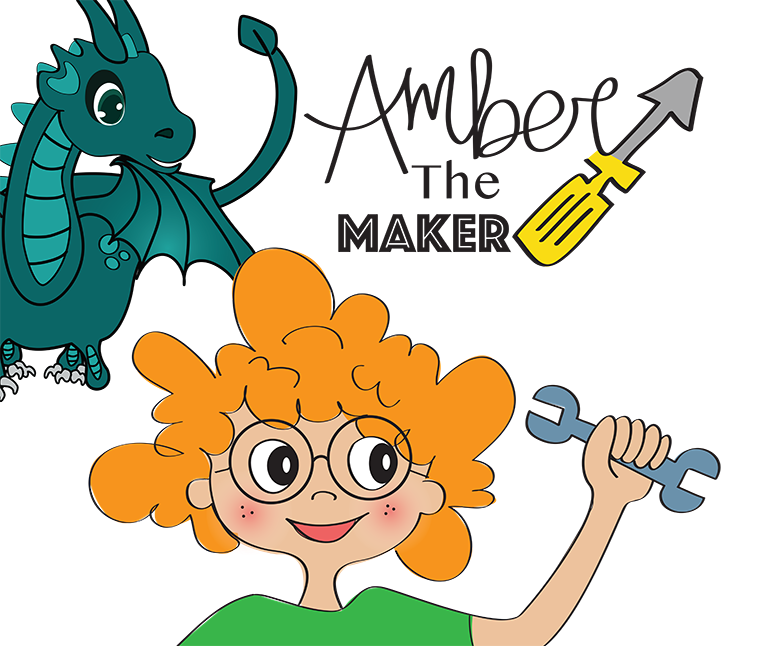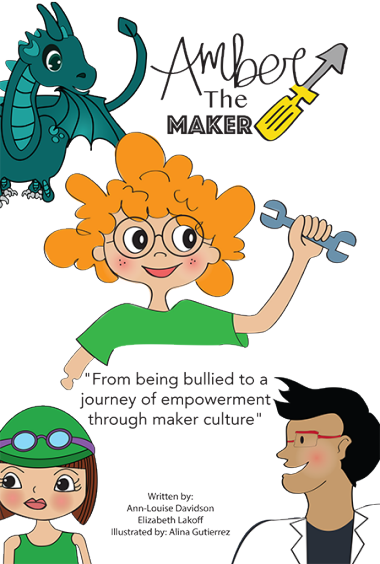
For most of us, maker culture conjures images of 3D printers and DIY electronic projects.
But for Ann-Louise Davidson, professor in the Department of Education and Concordia University Research Chair in Maker Culture (Tier 2), that's only the beginning - and the educational possibilities are endless.
So she decided to write a children's book.
"Since I was a child, the world has changed a lot," says Davidson. "The lessons we learned from Little Red Riding Hood and The Three Little Pigs were great, but we need new literature for children based on contemporary narratives."
"I wanted to write a story for curious kids and those who like to dream of impossible things and tell them that if they reach out to the maker community, the sky is the limit."
With this in mind, she teamed up with her student and collaborator Elizabeth Lakoff (MA 19) to pen Amber the Maker, a story aimed at children aged seven to 12 about a little girl who explores makerspaces to become empowered.
An amputee who is missing a hand, Amber is bullied by her teammates during swim practice, due to a clunky prosthetic that doesn't allow her to swim as fast as the rest of the group.
Initially discouraged, Amber soon gets a new lease on life thanks to a magic dragon who introduces her to the world of making. The dragon inspires Amber to visit makerspaces where she can learn the skills to create a new, faster swimming prosthesis.

The inspiration for Amber
While Davidson had a handle on the "maker" aspect of the text, for help telling Amber's story she reached out to Lakoff, whose son, Elliott, is a congenital amputee.
"When Ann-Louise shared the initial idea with me, I was incredibly excited," says Lakoff.
"As a former teacher and mom, I know how important it is for kids to see themselves reflected in stories. I wanted to help tell a story that featured a disabled main character and that celebrated difference."
Lakoff, who learned of her son's need for amputation the day he was born, says she initially felt overwhelmed and uncertain. But with time and the support of the War Amps Child Amputee program, she soon realized how incredibly resourceful amputee children and families are.
"I saw kids helping their prosthetist with design ideas for new prosthetic devices. Parents were making their own adaptations and devices for their children in their garages. It was really amazing," she says.
"As Elliott got older, he also faced the same kind of bullying that you see in the story. Sometimes, children would tell Elliott that he couldn't do something because he only had one arm. It was rare, but there were also times when kids would point, laugh, or even scream and run away. Those were the worst times," Lakoff adds.
"However, Elliott has become incredibly resilient, kind, and has persevered even through the toughest of bullying."
Hear two children read from 'Amber the Maker':
Everyday miracles
Davidson has been observing what happens in makerspaces since 2014.
"Every day, miracles happen in these places," she says.
Watching people produce objects out of recycled materials or using 3D printers and laser cutters to create new things never fails to fascinate Davidson. "Frankly, what goes on in these spaces is amazing," she says.
"It takes time to build the skills. This is why in the story Amber had to learn how to use the machines and design objects before she could undertake her big project. Also, makerspaces are disruptive, because it is possible to short-circuit production lines and product design that happens in big companies, but it doesn't mean that we have to ignore the expertise of professionals. This is why Amber consults with her prosthetist in the book."
Individualized program PhD student Alina Gutiérrez (BFA 09, MA 16) illustrated the book. Her research focuses on the long-term impact of using visual tools to install change and create a call for action. She jumped at the chance to be involved with the project.
"We have the power to make a difference in someone's life by sharing a message that matters. I believe kids need to hear that things are sometimes rough, but that they are not alone," Gutiérrez says. "This is also a great opportunity to spread the word about makerspaces, these hidden gems where people are able to dream and make their dreams a reality."
A pedagogical tool
The team sees a lot of educational potential in the book. Davidson is already consulting with philosophers, neuropsychologists, teachers and other community stakeholders to create pedagogical materials that will accompany the book.
"We want public impressions and reactions," says Davidson. "My hope is that parents and teachers will read this story for kids."
"I want to reach and inspire children like my son," adds Lakoff, who hopes all children will feel motivated by the way the character of Amber becomes a problem solver and learns to stand up for herself.
"I have learned so much about maker culture from Ann-Louise and was encouraged by all that could be done - there are so many possibilities!"
On October 6 at 4 p.m., a group of children will read 'Amber the Maker' at 4TH SPACE.
Watch this video to learn more about makerspaces.






